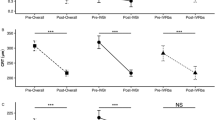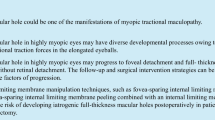Summary
Background
The aim of this study was to determine the size of the foveal avascular zone (FAZ) by optical coherence tomography angiography (OCTA) after surgery for an idiopathic epiretinal membrane (ERM).
Methods
This study comprised a retrospective, observational case series. In all, 17 eyes of 17 patients with an idiopathic ERM were studied. Pars plana vitrectomy was performed with internal limiting membrane (ILM) peeling. The area of the superficial FAZ and the central macular thickness were determined by OCTA. Retinal sensitivity was measured by microperimetry.
Results
The size of the preoperative FAZ was difficult to determine because of the poor images of the capillary network. The size of the FAZ was smaller than that of the control eyes at all time points (p < 0.001). There was a significant inverse correlation between the area of the postoperative FAZ and the CMT (r = −0.480, p = 0.048 at 3 months; r = −0.565, p = 0.018 at 6 months; r = −0.534, p = 0.027 at 12 months), and between the area of the FAZ and retinal sensitivity (r = −0.622, p = 0.008 at 3 months; r = −0.578, p = 0.015 at 6 months), postoperatively.
Conclusion
The significantly small FAZ after ERM surgery indicates a macular deformity caused by a contraction of the ERM. This change persisted for at least 12 months after the surgery.
Zusammenfassung
Hintergrund
Ziel der vorliegenden Studie war es, die Größe der fovealen avaskulären Zone (FAZ) mittels optischer Kohärenztomographie-Angiographie („optical coherence tomography angiography“, OCTA) nach Operation wegen einer idiopathischen epiretinalen Membran (ERM) zu ermitteln.
Methodik
Dieser Ansatz umfasste eine retrospektive Beobachtungsstudie i. S. einer Fallserie. Insgesamt wurden 17 Augen von 17 Patienten mit idiopathischer ERM untersucht. Es wurde eine Pars-plana-Vitrektomie mit Ablösen der inneren Grenzmembran („inner limiting membrane“, ILM) durchgeführt. Unter Einsatz der OCTA wurde der Bereich der oberflächlichen FAZ und die zentrale Makuladicke („central macular thickness“, CMT) bestimmt. Die Mikroperimetrie diente der Erfassung der retinalen Sensitivität.
Ergebnisse
Die Größe der präoperativen FAZ war wegen der schlechten Qualität der Bilder des kapillaren Netzes schwierig zu ermitteln. Zu allen Zeitpunkten war die FAZ-Größe der untersuchten Patientengruppe geringer als die der Kontrollaugen (p < 0,001). Es bestand eine signifikante inverse Korrelation zwischen dem Bereich der postoperativen FAZ und der zentralen Makuladicke (r = −0,480; p = 0,048 nach 3 Monaten; r = −0,565; p = 0,018 nach 6 Monaten; r = −0,534; p = 0,027 nach 12 Monaten), und zwischen dem Bereich der FAZ und der retinalen Sensitivität (r = −0,622; p = 0,008 nach 3 Monaten; r = −0,578; p = 0,015 nach 6 Monaten) postoperativ.
Schlussfolgerung
Die in signifikanter Weise kleinere FAZ nach der ERM-Operation wies auf eine Makuladeformität hin, die durch eine Kontraktion der ERM bedingt ist. Diese Änderung bestand mindestens 12 Monate nach der Operation.






Similar content being viewed by others
References
Smiddy WE, Maguire AM, Green WR, et al. Idiopathic epiretinal membranes. Ultrastructural characteristics and clinicopathologic correlation. Ophthalmology. 1989;96(6):811–20. https://doi.org/10.1016/S0161-6420(89)32811-9. discussion 821.
Jia Y, Tan O, Tokayer J, et al. Split-spectrum amplitude-decorrelation angiography with optical coherence tomography. Opt Express. 2012;20(4):4710–25. https://doi.org/10.1364/OE.20.004710.
Huang Y, Zhang Q, Thorell MR, et al. Swept-source OCT angiography of the retinal vasculature using intensity differentiation-based optical microangiography algorithms. Ophthalmic Surg Lasers Imaging Retina. 2014;45(5):382–9. https://doi.org/10.3928/23258160-20140909-08.
Jia Y, Bailey ST, Hwang TS, et al. Quantitative optical coherence tomography angiography of vascular abnormalities in the living human eye. Proc Natl Acad Sci USA. 2015;112(18):E2395–E402. https://doi.org/10.1073/pnas.1500185112.
de Carlo TE, Chin AT, Bonini Filho MA, et al. Detection of Microvascular changes in eyes of patients with diabetes but not clinical diabetic retinopathy using optical coherence tomography angiography. Retina. 2015;35(11):2364–70. https://doi.org/10.1097/IAE.0000000000000882.
Ishibazawa A, Nagaoka T, Takahashi A, et al. Optical coherence tomography angiography in diabetic retinopathy: a prospective pilot study. Am J Ophthalmol. 2015;160(1):35–44e.1. https://doi.org/10.1016/j.ajo.2015.04.021.
Suzuki N, Hirano Y, Yoshida M, et al. Microvascular abnormalities on optical coherence tomography angiography in macular edema associated with branch retinal vein occlusion. Am J Ophthalmol. 2015;161:126–132.e1. https://doi.org/10.1016/j.ajo.2015.09.038.
Kashani AH, Lee SY, Moshfeghi A, et al. Optical coherence tomography angiography of retinal venous occlusion. Retina. 2015;35(11):2323–31. https://doi.org/10.1097/IAE.0000000000000811.
de Carlo TE, Bonini Filho MA, Chin AT, et al. Spectral-domain optical coherence tomography angiography of choroidal neovascularization. Ophthalmology. 2015;122(6):1228–38. https://doi.org/10.1016/j.ophtha.2015.01.029.
Kuehlewein L, Bansal M, Lenis TL, et al. Optical coherence tomography angiography of type 1 neovascularization in age-related macular degeneration. Am J Ophthalmol. 2015;160(4):739–748e.2. https://doi.org/10.1016/j.ajo.2015.06.030.
El Ameen A, Cohen SY, Semoun O, et al. Type 2 neovascularization secondary to age-related macular degeneration imaged by optical coherence tomography angiography. Retina. 2015;35(11):2212–8. https://doi.org/10.1097/IAE.0000000000000773.
Tanaka K, Mori R, Kawamura A, et al. Comparison of OCT angiography and indocyanine green angiographic findings with subtypes of polypoidal choroidal vasculopathy. Br J Ophthalmol. 2017;101(1):51–5. https://doi.org/10.1136/bjophthalmol-2016-309264.
Balaratnasingam C, Yannuzzi LA, Spaide RF. Possible choroidal neovascularization in macular telangiectasia type 2. Retina. 2015;35(11):2317–22. https://doi.org/10.1097/IAE.0000000000000887.
Gaudric A, Krivosic V, Tadayoni R. Outer retina capillary invasion and ellipsoid zone loss in macular telangiectasia type 2 imaged by optical coherence tomography angiography. Retina. 2015;35(11):2300–6. https://doi.org/10.1097/IAE.0000000000000799.
Baba T, Kakisu M, Nizawa T, et al. Superficial foveal avascular zone determined by optical coherence tomography angiography before and after macular hole surgery. Retina. 2017;37(3):444–50. https://doi.org/10.1097/IAE.0000000000001205.
Carpineto P, Mastropasqua R, Marchini G, et al. Reproducibility and repeatability of foveal avascular zone measurements in healthy subjects by optical coherence tomography angiography. Br J Ophthalmol. 2016;100(5):671–6. https://doi.org/10.1136/bjophthalmol-2015-307330.
Shahlaee A, Pefkianaki M, Hsu J, Ho AC. Measurement of foveal avascular zone dimensions and its reliability in healthy eyes using optical coherence tomography angiography. Am J Ophthalmol. 2016;161:50–55e.1. https://doi.org/10.1016/j.ajo.2015.09.026.
Cho KH, Park SJ, Cho JH, et al. Inner-retinal irregularity index predicts postoperative visual prognosis in idiopathic epiretinal membrane. Am J Ophthalmol. 2016;168:139–49. https://doi.org/10.1016/j.ajo.2016.05.011.
Samara WA, Say EA, Khoo CT, et al. Correlation of foveal avascular zone size with foveal morphology in normal eyes using optical coherence tomography angiography. Retina. 2015;35(11):2188–95. https://doi.org/10.1097/IAE.0000000000000847.
Ripandelli G, Scarinci F, Piaggi P, et al. Macular pucker: to peel or not to peel the internal limiting membrane? A microperimetric response. Retina. 2015;35(3):498–507. https://doi.org/10.1097/IAE.0000000000000330.
Park SW, Byon IS, Lee JE, Oum BS. Analysis of the ganglion cell layer and photoreceptor layer using optical coherence tomography after idiopathic epiretinal membrane surgery. Graefes Arch Clin Exp Ophthalmol. 2015;253(10):1829–30. https://doi.org/10.1007/s00417-015-3002-6.
Author information
Authors and Affiliations
Corresponding author
Ethics declarations
Conflict of interest
T. Baba, M. Kakisu, T. Nizawa, T. Oshitari, and S. Yamamoto declare that they have no competing interests.
Rights and permissions
About this article
Cite this article
Baba, T., Kakisu, M., Nizawa, T. et al. Study of foveal avascular zone by OCTA before and after idiopathic epiretinal membrane removal. Spektrum Augenheilkd. 32, 31–38 (2018). https://doi.org/10.1007/s00717-017-0375-4
Received:
Accepted:
Published:
Issue Date:
DOI: https://doi.org/10.1007/s00717-017-0375-4
Keywords
- Idiopathic epiretinal membrane
- Foveal avascular zone
- Optical coherence tomography angiography
- Vitrectomy
- Internal limiting membrane




